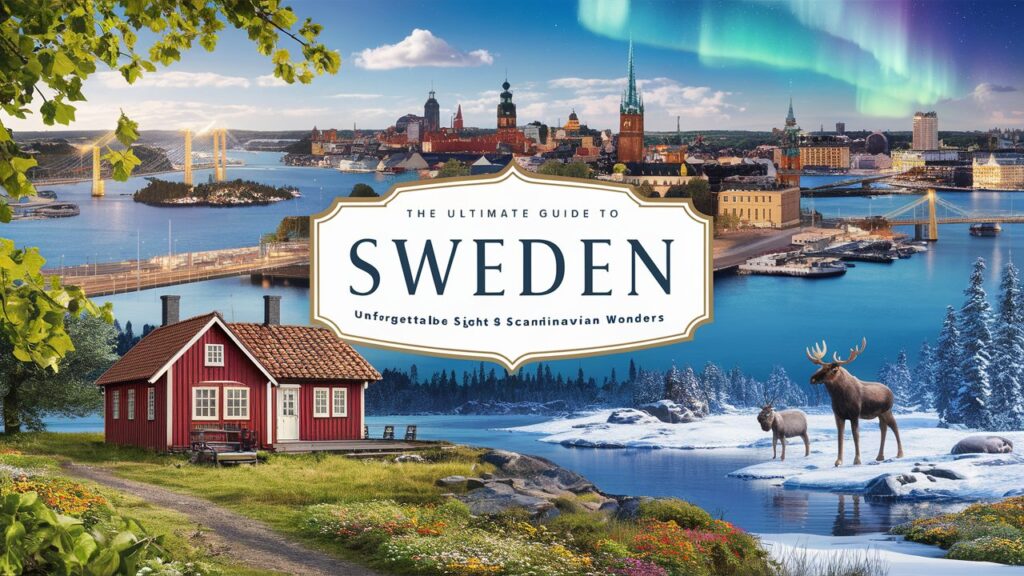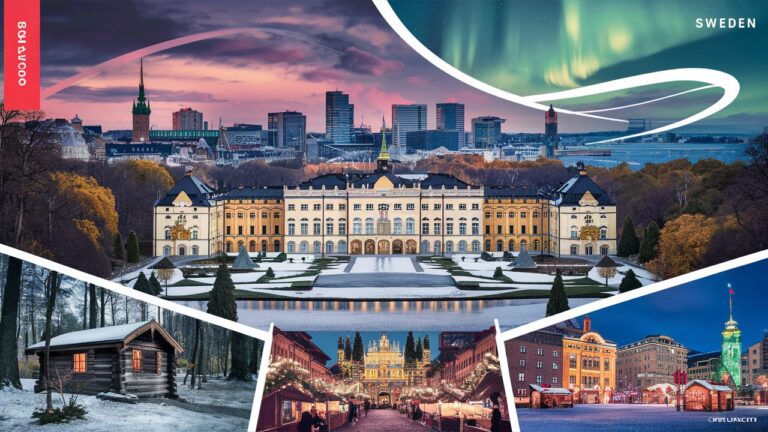Introduction: The Allure of Sweden’s Diverse Beauty
Sweden captivates travelers with its breathtaking contrasts—pristine Arctic wilderness, medieval cobblestone towns, and innovative urban design coexist in a nation rich in history and natural splendor. From the ethereal Northern Lights in Lapland to the sun-drenched archipelagos of the south, Sweden offers experiences blending deep cultural heritage with cutting-edge sustainability. The country’s “allemansrätten” (right of public access) encourages exploration of its 90,000+ lakes, vast forests, and dramatic coastlines, making it a paradise for outdoor enthusiasts and culture seekers alike 411. Whether you’re kayaking past remote islands, marveling at a salvaged 17th-century warship, or savoring cinnamon buns in a waterfront café, Sweden promises unforgettable adventures.
Stockholm: Where History Meets Modern Scandinavian Charm
Gamla Stan (Old Town) is Stockholm’s enchanting heart, founded in 1252. Wander its narrow, cobblestone lanes past ochre-hued merchant houses, Stortorget square, and the Royal Palace—home to 600 rooms and daily changing-of-the-guard ceremonies. Nearby, Djurgården Island blends culture and nature: the Vasa Museum displays an impeccably preserved 1628 warship salvaged after 333 years underwater, while Skansen, the world’s oldest open-air museum, showcases 150 historic Swedish buildings and Nordic wildlife 356. For royal grandeur, take a ferry to Drottningholm Palace, a UNESCO-listed Baroque masterpiece still serving as the royal family’s residence. Its Chinese Pavilion and ornate theater epitomize 17th-century opulence 36. Don’t miss City Hall’s Golden Hall, adorned with 18 million mosaic tiles, where Nobel Prize banquets unfold 3.
Gothenburg & the West Coast: Coastal Cool and Archipelagic Adventures
Sweden’s second city, Gothenburg, exudes a laid-back maritime spirit. Stroll along Liseberg Amusement Park’s thrilling roller coasters and botanical gardens, or explore the Feskekôrka fish market—a haven for fresh shrimp and herring. The city’s dual archipelagos are a summer highlight: the car-free southern islands (like Vrångö) offer sandy beaches, while the rocky northern isles beckon kayakers 346. Further north, the Bohuslän coast enchants with picturesque fishing villages. Smögen’s cliffside boardwalk buzzes with seafood restaurants, while Fjällbacka—crowned by dramatic granite cliffs—was a favorite of Ingmar Bergman 5. The Göta Canal, a 190-km engineering marvel from the 19th century, connects Gothenburg to Stockholm via lakes, locks, and lush countryside—perfect for cycling or vintage boat cruises 34.
Swedish Lapland: Arctic Wilderness and Cultural Treasures
In Sweden’s far north, Kiruna embodies Arctic extremes. Visit the LKAB iron-ore mine (the world’s largest) or the iconic Icehotel in Jukkasjärvi, rebuilt annually from Torne River ice with ethereal ice sculptures and Northern Lights viewing packages 3612. For aurora hunting, Abisko National Park boasts microclimates that ensure clear skies—ride the chairlift to Aurora Sky Station for prime sightings 612. Lapland’s Indigenous Sámi culture thrives in Jokkmokk, where the Ájtte Museum details Sami heritage, and February’s Winter Market features reindeer races and duodji crafts 511. Hike the Kungsleden (King’s Trail), a 440-km route through the Laponia Wilderness—a UNESCO site of glaciers, peaks, and reindeer migration paths 511.
Gotland & the South: Medieval Magic and Rural Idylls
The Baltic island of Gotland centers on Visby, a UNESCO World Heritage site ringed by 13th-century walls and 44 watchtowers. Its cobbled lanes, rose-covered ruins, and St. Mary’s Cathedral evoke Hanseatic trading history. In August, Medieval Week features jousting and mead halls 3512. Southern Sweden’s Skåne region offers bucolic charm. Österlen’s rolling farmland, apple orchards, and Sandhammaren Beach (often ranked Europe’s finest) invite cycling and foraging. Discover the Ales Stenar ship-shaped stone setting, a Viking-era mystery 45. Nearby, Malmö impresses with the Turning Torso skyscraper and Ribersborg Beach, linked to Copenhagen via the Öresund Bridge 5. For royal flair, Öland island hosts Solliden Palace (the royal summer home) and Borgholm Castle’s haunting ruins 45.
Dalarna & Central Sweden: Folklore, Lakes, and Craft Traditions
Lake Siljan, a 70-km-wide glacial basin, anchors the folklore-rich Dalarna region. Explore Rättvik’s lakeside villages, Tällberg’s red cottages, and Nusnäs, where Dala horses are hand-carved and painted 5[citation:9]. Falun’s copper mine, a UNESCO site, reveals 1,000 years of industrial history through underground tours 5. In summer, join Midsommar celebrations—dance around flower-adorned maypoles and feast on herring and strawberries 4. Nearby Uppsala blends ancient and academic: Gamla Uppsala’s royal burial mounds date to the 6th century, while the 15th-century cathedral and Linnaean Gardens honor botanist Carl Linnaeus 5.
Swedish Nature & Outdoor Pursuits: From Archipelagos to Arctic Tundra
Sweden’s landscapes demand immersion. The Stockholm Archipelago’s 30,000 islands are explored via kayak, sailboat, or ferry—grill seafood on car-free Grinda or Sandhamn 45. Hikers prize Abisko’s Kungsleden Trail and Skuleskogen National Park in the High Coast (a rising UNESCO area) 511. Winter transforms Lapland into a snow playground: dog-sledding, ice-skating on frozen bays, and cross-country skiing shine in Åre or Vemdalen 11. Summer brings wild swimming in Vättern Lake or biking through Gothenburg’s sustainable city paths 411.
Cultural Experiences & Cuisine: Fika, Design, and Vikings
Sweden’s culture blends tradition and innovation. Embrace fika—the art of the coffee break—with cinnamon buns at a Stockholm courtyard café 4. Sample smörgåsbord feasts featuring gravadlax, meatballs, and cloudberries. Design enthusiasts will adore Gothenburg’s Konstmuseum (Nordic art) and Malmö’s Moderna Museet 35. For history, Kalmar Castle’s Renaissance grandeur and the Glasriket (Kingdom of Crystal)’s glassblowing workshops showcase regional craftsmanship 5.
Table: Sweden’s Must-See Attractions by Region
| Region | Top Attractions | Unique Experience |
| Stockholm | Gamla Stan, Vasa Museum, Drottningholm Palace, Skansen | Archipelago kayaking at sunset |
| West Coast | Gothenburg Archipelagos, Liseberg, Bohuslän Coast, Göta Canal | Oyster foraging in Grebbestad |
| Lapland | Icehotel, Abisko Aurora, Sámi Jokkmokk Market, Kungsleden Trail | Reindeer sledding under Northern Lights |
| Gotland/South | Visby Old Town, Österlen Farmlands, Malmö’s Turning Torso, Öland Castles | Medieval Week axe-throwing in Visby |
| Dalarna | Lake Siljan, Falun Mine, Dala Horse Workshops, Uppsala Mounds | Midsommar dancing in traditional costume |
Conclusion: Crafting Your Swedish Journey

Sweden’s magic lies in its harmonious contrasts—cosmopolitan creativity alongside untamed wilderness, ancient rituals fused with sustainable innovation. Whether you’re exploring Stockholm’s museums, foraging in Österlen, or sleeping in an ice suite under the aurora, each experience reveals a nation deeply connected to its environment and heritage. With efficient trains and flights linking cities to remote national parks, designing a tailored itinerary is seamless. As Swedes say, “Det finns inget dåligt väder, bara dåliga kläder” (“There’s no bad weather, only bad clothing”)—come prepared, and Sweden’s four seasons will unveil their wonders.
Frequently Asked Questions
Q: What is the best time to visit Sweden?
A: May–September offers long days (midnight sun above the Arctic Circle), wild swimming, and festivals. December–March is ideal for winter sports/Northern Lights. Midsommar (June) and Christmas markets are cultural peaks 411.
Q: How many days are sufficient for Sweden?
A: Allow 4–5 days for Stockholm and its archipelago; add 3 days for Gothenburg/archipelagos or Lapland. A 10–14-day trip could cover all regions via train/flights 5.
Q: Is Sweden suitable for nature lovers?
A: Absolutely! Hike Kungsleden, kayak Gothenburg’s islands, swim in Vänern Lake, or join moose safaris. National parks like Abisko and Sarek offer pristine wilderness 4511.
Q: What unique accommodations exist?
A: Sleep in the Icehotel (–5°C rooms), treehouses in Harads, or historic manor houses (e.g., Tällberg). Archipelago cabins and Sámi lavvu tents add adventure 612.
Q: How accessible is Sweden without a car?
A: Trains (SJ) connect major cities; ferries serve archipelagos. Public transport in Stockholm/Gothenburg is excellent. Regional buses reach remote areas, but Lapland may require guided tours 511.
